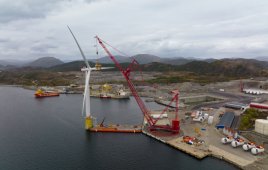
Wind-turbine failures carry hefty claims costs so monitoring a wind turbine’s health can reduce future risks, extend its life and increase reliability.
Wind-power projects represent significant capital investments of many millions. So it’s no surprise that, average claims for wind-turbine failures run between $200,000 and $600,000. With such hefty claim costs, it is important for insurers to understand the root cause of failures to reduce future risks. To fully understand the loss-adjustment process, renewable energy insurance company, GCube (www.gcube-insurance.com) has partnered with Romax Technology (www.romaxtech.com) to conduct forensic investigations of turbine failures. The partnership helps shed light on what contributes to a turbine’s overall health, and what extends its life and increases reliability, says GCube.
The insurance company says it has participated in all phases of wind farm project development and financing, from inception to the cost of lost electricity production. With claims carrying the large payouts cited, the company needed an in-depth investigator to accurately settle claims. GCube thought Romax a good fit after identifying its independent technical capability, and its understanding of forensics and design issues. Both companies also share similar visions for the proactive mitigation of risk through health-monitoring solutions to optimize risk management strategies. “We wanted to bring Romax’s expertise into the process,” says Chris Cioni, senior VP for Technical Servces and Claims at GCube. “Not just to simply investigate and repair or replace parts, but to get a better understanding of what causes failures.” Romax also offers an unbiased, objective view because both companies share many of the same clients.
Another benefit of partnering with Romax is its InSight software that monitors turbine health. GCube believes monitoring turbine health plays a large role in managing risks and reducing the cost of failures. Although the monitoring software is not currently considered an industry standard in wind turbines, the insurance company encourages clients to invest in it. “Monitoring turbine health lets insurers manage problems in advance rather than being caught flat-footed in response to unexpected failures,” says Cioni. “We are looking at incentives to promote the use of health monitoring software, such as Romax’s InSight.”
The insurance company says a significant factor influencing operational performance and risk tends to be environmental conditions. For example, the company is occasionally approached at an early stage of project development to advise on the insurance implications of turbine selection. An assessment includes advising on the risk profile for a given turbine in a particular location. This usually occurs when a new turbine OEM is looking to enter the market, or a project developer needs advice on the impact of the new equipment on premiums and deductibles. The arrangement lets the insurance company examine complex technical issues and helps clients make informed decisions. WPE
Filed Under: Featured, Insurance





Hi Nic,
I have heard some insurance policies in Australia say something along the lines of “if signs of the failure were known about in advance of the major component failure, that failure is not covered by the insurance policy”. Can you comment on the liklihood of such wording existing? It seems sensible to begin with, but could discourage policy holders from using their SCADA data to its full value to detect early signs of failure. Automated wind farm SCADA data analysis is something SCADA Miner also offers.
Tom